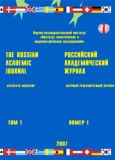О журнале
The Russian Academic Journal is one of the fundamental scientific publications on the territory of South of Russia, Greater Caucasus, Central Asia, Ukraine and Indochina, which are conducting an important mission on spreading in the international academic community works of Russian, Ukrainian, Caucasian and Asian scientists relating to regional range of problems; annually this journal publishes more than 120 scientific articles in Russian and English languages concerned with economy, management, political science, philosophy, philology, mathematics, informatics, chemistry, biology, geosciences. Authors of these articles are famous scientists from China, Ukraine, the USA, India, Afghanistan, Great Britain, Russia and other countries. Members of editorial team of the journal are working in three continents: Europe, North America and Asia, in six countries: Russia, Ukraine, India, Great Britain, the USA and Afghanistan.
In accordance with the resolution of the members of the editorial board, which has been drawn up on the meeting in the George Washington University (Washington, DC), starting January, 2014, the regional subjects make the domain of problems of the Russian Academic Journal. By general repute of the editorial board members, the international community fairly well understood any global processes, but as regards local, especially regional processes, there are considerable gaps. So, international members of the editorial board of the Russian Academic Journal are waiting from their authors any qualitative actual data relating to processes and events in their regions which are unavailable in any other scientific publications or in the Internet.
The general partner of the Russian Academic Journal is the Southern University (IMBL) (Russia, Rostov-on-Don). Publisher of the journal is the Research Institute “Institute for Political and Media Metric Research” with its DOI prefix (10.15535).
In the journal the main scientific results of theses on competition of a scientific degree of the doctor of science can be published. The journal is included in the Russian Index of Scientific Citing (RISC) of National electronic library of the Russian Federation, InfoBaseIndex, GoogleScholar, OCLC WorldCat, ROAR, BASE, OpenDOAR, RePEc, JournalTOCs, OAJI, ISI (UAE), DOAJ, Fedora (DURA SPACE), CrossRef, PORTICO, Ulrich`s (ProQuest), Exlibris, Socionet and funds of Library of the Congress of the United States of America.
The Russian Academic Journal represents a new generation of academic journals acting on the grounds of the principle of open access. As the scientific articles should be maximally wide spread, the Russian Academic Journal does not apply the copyright law for to restrict access and use of published material. On the contrary, the copyright law and any other legal instruments are applying for to achieve a continuous open access of journal audience to all articles published by the journal.
On its site the Russian Academic Journal uses a Canadian IT technologies development– the all-powerful content management system in the Internet, integrated into the Library System for North America and in the Index system of North American Universities – Open Journal System (OJS). Switch of the journal at a totally new level made it possible to enter into several international databases of scientific citing.
The Russian Academic Journal is one of those few journals in the south regions of Russia, which is assigning to each article of each author the international identifier of scientific article, DOI.
For to publish any scientific articles in the journal it is necessary to be registered as an author on the site of the journal and to get in contact with the executive editor of the journal:
E-mail: chief@wolfcorner.org
Научная область
Volume 31, issue 1
Содержание
There are two tasks the human resources are entrusted with. The first one is to increase productivity, and the second is to increase<br />qualification of professional life. At the beginning of 1990s, personnel management left its duty to the human resources management.<br />The human....
The organized industry in Turkey is operating since 1961. The companies located in the organized industrial zones aim only<br />manufacturing and try to deliver orders of customers on time in general. They provide supplies for whole manufacturing from<br />the organized industrial....
Job is an indispensable part of life. All employees face stress. The health sector has many properties that may lead to stress stemming<br />from its characteristic structure. Due to the fact that the slightest mistake may lead to loss of human life, satisfaction or dissatisfaction<br....
The paper refers to nature and the necessity of a strategic approach to financing in the industry. The author considers reasons and<br />characteristics of an industrial enterprise financial strategy under contemporary complicated economic conditions. A methodology<br />of selection....
The author has analyzed the sense and support of a mechanism of industrial enterprise financial risk management, taking into account<br />a dynamically changeable economic environment. The article contains the main approaches to methodical support of financial<br />risk assessment on....
Abstract<br />Quality of life of employees in high-risk units was examined in this article. Accordingly, the high-risk units’ staff is working in raising the<br />quality of life, by living and working conditions, for to eliminate the problems related to the risk of reduction any....




